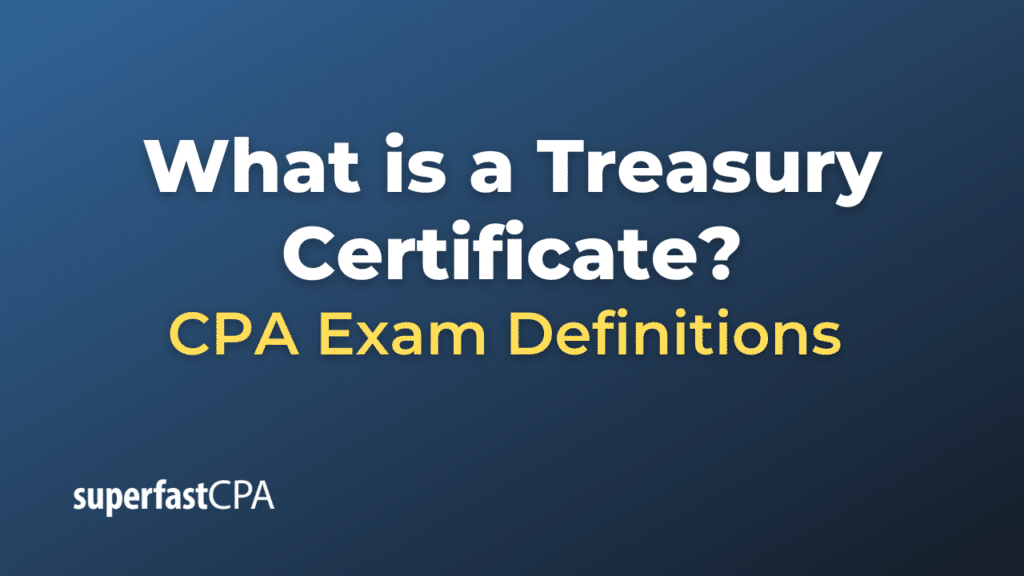Treasury Certificate
A Treasury Certificate, historically speaking, was a type of short-to-medium-term debt instrument issued by the U.S. Treasury. They were primarily used in the first half of the 20th century but were eventually replaced by other forms of U.S. Treasury securities.
Here are some key points about Treasury Certificates:
- Maturity: Treasury Certificates typically had maturities ranging from a few months to a few years, placing them between Treasury Bills (short-term) and Treasury Bonds (long-term) in terms of their duration.
- Interest : Unlike T-Bills which are sold at a discount and don’t pay periodic interest, Treasury Certificates did pay semi-annual interest to their holders.
- Issuance: They were typically issued to raise funds to cover specific government expenditures. The U.S. Treasury would issue these certificates with the promise to repay the holder the face value upon maturity.
- Physical Certificate: In the days of paper securities, an actual certificate was issued to the bondholder. It would include details such as the certificate’s face value, interest rate, and maturity date.
- Replacement : Treasury Certificates were phased out and replaced by the U.S. Treasury with other securities like Treasury Notes, which have similar maturity ranges and also pay semi-annual interest. Treasury Notes are commonly issued with maturities of 2, 3, 5, 7, and 10 years.
- Safety: Just like other U.S. government securities, Treasury Certificates were considered a safe investment because they were backed by the full faith and credit of the U.S. government.
- Historical Context: They were especially popular during and after World War II as a way for citizens to lend money to the government to support the war effort.
It’s worth noting that while the term “Treasury Certificate” specifically refers to these older U.S. debt instruments, the word “certificate” can be used in various contexts in finance. Always ensure clarity when discussing financial instruments, especially when dealing with historical or less common terms.
Example of a Treasury Certificate
Let’s look at a hypothetical example to understand how a Treasury Certificate might have operated back when they were issued:
Scenario: Investing in a 2-year Treasury Certificate during the 1940s
Imagine you’re living in the 1940s, post-World War II. The U.S. government is issuing Treasury Certificates to raise funds to cover war-related expenditures and other budgetary needs. You decide to buy a Treasury Certificate to support the government and earn some interest on your savings.
Treasury Certificate Details:
- Face Value: $5,000
- Interest Rate (Coupon Rate) : 2.5% per annum
- Maturity: 2 years
1. Interest Payments:
- The Treasury Certificate pays interest semi-annually, so you will receive interest payments twice a year.
- Your annual interest would be: 2.5% of $5,000 = $125.
- Semi-annual interest would be: $125 ÷ 2 = $62.50.
- Every 6 months, for the next 2 years, you’d receive $62.50 in interest.
2. Maturity:
- After 2 years, the Treasury Certificate matures.
- In addition to the last semi-annual interest payment, you’d receive back the certificate’s face value of $5,000 from the U.S. government.
3. Total Returns:
- Over the 2-year period, you would earn: 2 years × $125/year = $250 in interest payments.
- Combining this with the original principal amount: $250 + $5,000 = $5,250.
- This means your $5,000 investment would yield a total of $5,250 over the 2-year period.
Physical Certificate:
- Upon purchasing the Treasury Certificate, you’d receive a physical paper certificate. This document would be proof of your investment and would detail the face value, interest rate, and maturity date. You’d have to safely store this paper certificate and present it at the time of redemption (when cashing in at maturity).
While this is a simplified example, it provides a clear picture of how Treasury Certificates functioned. Investors were essentially lending money to the government, and in return, they received regular interest payments and the promise of the full principal amount returned at maturity. The actual historical interest rates and specific terms might have varied based on the period and the prevailing economic conditions.













